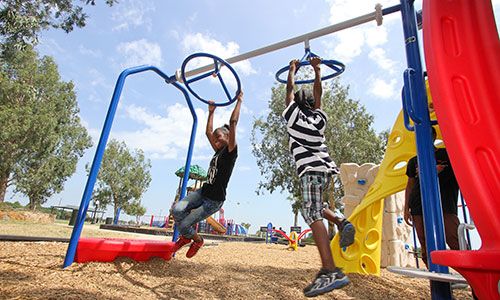
Once the summer winds down and school starts up again, you can be sure that your school’s playground will be in full use. Ensuring that your school’s playground is in sync with safety standards should be a top priority before the start of the school year for obvious reasons. Unfortunately, over 20,000 children each year sustain some sort of injury on a playground. Although playground injuries are inevitable, there are plenty of measures that can be taken to minimize them. Below are five tips on how to ensure playground safety at your school or organization.
1. Check your playground regularly
1. Even after the school year begins or children come back from winter or spring break, it is always a good idea to check your playground on a regular basis. This doesn’t mean that you have to devote hours each week to it, but a quick check at the end of the day goes a long way. It’s also a good idea to give your playground a thorough check at the end of each week. Pull on the equipment and and bang it around a little to make sure that everything is bolted in place and there are no loose ends. If you find something that seems out of the ordinary, don’t hesitate to fix it right away.
2. Get a certified Safety Playground Inspection
This is related to the first tip, but takes it a step further. Since you are not an expert, the wise thing to do is to have an expert come to your school’s playground once a year and perform a certified playground inspection. You may think that a playground inspection is just another expense, but it is a measure that can prevent a major headache and financial consequences. If you are in Washington DC, Maryland or Northern Virginia, read more about our certified playground safety inspections. A certified playground inspector will thoroughly check every inch of your playground and provide your organization with a detailed report.
3. Make sure there is adequate surfacing
While you may naturally focus first on the equipment, don’t forget about the surfacing underneath. Even if the equipment is up to par, kids sometimes fall on the ground. It’s just part of being a kid, so it is best to be prepared for those falls. Make sure that your playground has at least 8 inches of mulch, wood chips or certified Poured-in-Place surfacing. Certified Engineered Wood Fiber is a form of mulch that has become popular with many schools, daycares and organizations in recent years. You should also make sure that surfacing extends at least 6 feet outward from each playground structure. If there is a very high structure, you might want to consider 10 feet.
4. Have proper spacing between play structures
Spacing is one of the keys to ensuring playground safety. If you have guard rails or protective borders around your playground structures, make sure there is adequate space between the structure and the railing or bordering. You also want to have at least 3 to 5 feet of space between each play structure. Having too many play structures cramped into a small space is never a good idea. You want to create a clear space in between structures that easily allows for a clean impact on the surfacing below.
5. Make sure children are using the appropriate equipment for their age group
This might seem like a no-brainer, but it is one that is easily overlooked and the reality is that you might be too busy sometimes to make sure that each child is playing on the appropriate equipment according to his or her age group. However, making sure that children are using the right equipment for their age will go a long way in preventing injuries. Although playgrounds are often designed for multiple age groups, younger children are more prone to injury on certain equipment that might be better suited for 10 or 12-year-olds. For children of preschool age, have smaller steps for crawl spaces, low platforms with short ladders, shorter slides, no rope or chain climbers or sliding poles.
Following the five tips mentioned above should help improve the safety of your playground. The main thing really is just to consistently check the play structures and the areas around it. Finally, a little diligence and common sense will keep your playground safe.
